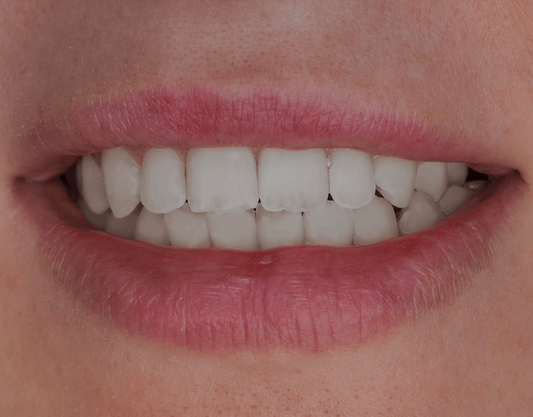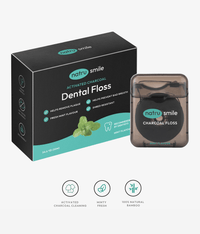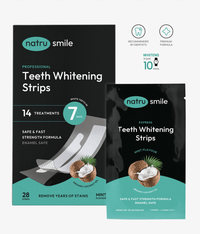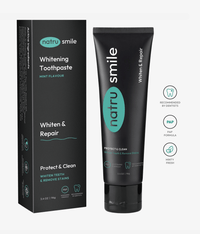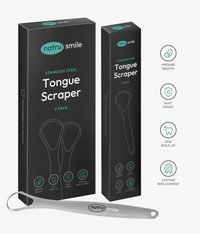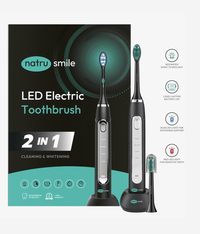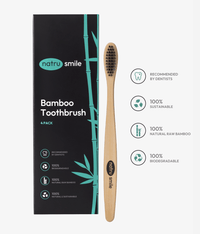
All products are certified by dental expert Dr. Greg Grillo
If your teeth are starting to look thin or transparent around the edges when you look in the mirror, you could be getting translucent teeth. This dental condition occurs when the enamel on your teeth gets worn down over time.
Unfortunately, once enamel is lost, you cannot restore tooth enamel naturally. This is because tooth enamel does not contain living cells, so it can’t regenerate itself. This fact makes recognizing and treating this condition more important than ever. If you have translucent teeth, you’re in good company.
According to the World Health Organization, nearly half of all people worldwide suffer from some sort of dental condition. Help is here, though. In this article, we’ll help you recognize the causes of transparent teeth and explore how to fix them at home and with professional help.
Keep reading to get the information you need to improve your smile!
What Causes Transparent Teeth?
Having translucent teeth isn’t normal. There are many factors, both environmental and biological, that can contribute to the erosion of enamel which then causes teeth to appear translucent. Here we will break down some of these causes:
Acidic Foods And Drinks
Tooth enamel acts like armor, protecting our teeth from damage and decay. Unfortunately, foods and drinks high in acid will attack and degrade our teeth, resulting in translucent enamel over time. Some examples of foods and drinks that can do this are:
- Citrus fruits like oranges and lemons
- Carbonated beverages such as soda or energy drinks
- Sports drinks, including Gatorade and Powerade
- Fruit juices high in citric acid or with additional sugar added
- Vinegar or vinegar-based dressings or marinades
- Red and white wines
- Coffee and tea, especially those containing sugar
- Tomatoes and tomato-based sauces, including ketchup
The double-whammy from eating or drinking some of these foods is that they can create an environment where bacteria can thrive, leading to more cavities and, in turn, more tooth transparency.
While cutting these foods from your diet to prevent acid erosion and translucent teeth might be tempting, remember that eating foods in moderation is vital for your overall health. An easy way to combat acidity and its effects on your teeth are to wash your mouth with water after eating or drinking these foods.
Frequent Vomiting
Frequent vomiting can be a symptom of many conditions, including bulimia nervosa, hyperemesis gravidarum (chronic morning sickness), side effects of medications, acid reflux, or gastrointestinal issues.
When people vomit, stomach acid is regurgitated up the esophagus, coating the tongue, teeth, and gums. This substance eats away at tooth enamel, slowly eroding this layer of protection. When you vomit repeatedly, it will result in tooth sensitivity, susceptibility to cavities, and transparent teeth.
To stop your enamel from eroding, it's important to address the cause of your vomiting and take additional dental measures to counteract the effects. These can include regular brushing and flossing, gargling with a fluoride mouthwash, and seeking the care of a dental professional.
Enamel Hypoplasia
Enamel hypoplasia is a condition that causes the enamel of the teeth to become thinner and more prone to wear and tear than usual. Also called congenital enamel hypoplasia or amelogenesis imperfecta, 1 out of 14,000 people in the US suffer from this condition.
This defect can be inherited or caused by medications, pre-natal issues, trauma, malnutrition, or other environmental exposures during tooth development.
Along with teeth transparency, other tell-tale signs of enamel hypoplasia include deformities to the outer appearance of the teeth. These signs can consist of white spots, pits, or discoloration.
Enamel hypoplasia can occur independently or as a symptom of hereditary conditions such as Usher or Heimler syndromes.
Celiac Disease
Celiac disease is categorized as an autoimmune disease. When celiac patients eat gluten, the body attacks the small intestine. After repeated attacks, the small intestine becomes damaged, and you will be unable to absorb many essential nutrients from your food.
Malnutrition caused by celiac disease causes many symptoms, such as weight loss, diarrhea, and discolored, pitted, or translucent teeth. Often with celiac patients, dental irregularities appear on both sides of the mouth, usually on the molars and incisors.
Dry Mouth
Saliva is essential to maintain dental health. Saliva helps us chew and moisten our food for easy swallowing and washes away any food particles from the teeth and gums. Saliva also contains phosphate and calcium, which help build and fortify your enamel.
Xerostomia, also known as dry mouth, is a condition where we cannot manufacture enough saliva to keep our mouth wet. The result of a dry mouth can be transparent enamel because our mouths lack the minerals usually supplied by our saliva to keep our teeth strong.
High Sugar Diet
With today’s overprocessed foods, it is easy to consume too much sugar. When you eat too many sugary foods, the sugar will leave a sticky coating on the outside of your teeth.
Over time, this coating will slowly weaken and destroy your enamel, and eventually, your teeth will have a clear glassy look. The answer to this problem is straightforward. Simply cut back on your sugary food intake, and you can stop this process in its tracks.
Gastrointestinal (GI) Problems
It's important to realize that everything is interconnected in your body. If you suffer from gastrointestinal (GI) issues, it can affect every part of your body, including your mouth and teeth.
GI conditions like GERD, acid reflux, Crohn's disease, or celiac disease all affect your teeth in two ways.
First, regurgitated acid will wear down the enamel of your teeth, exposing the dentin underneath. This process gives the illusion of glassy teeth.
Second, GI conditions make it difficult for your body to absorb the nutrients it needs to stay healthy, including those like vitamin D and calcium that build and protect your bones and teeth.
Brushing Too Hard
Even though it feels good to brush your teeth until they’re squeaky clean, you run the risk of doing damage if you are too enthusiastic. When you brush with too much pressure, you can wear away your teeth and eventually cause translucent enamel.
The answer to this problem is to get a softer toothbrush, exert less pressure, and brush at a 45-degree angle. You could also buy a specialized teeth whitening electric toothbrush to get a deeper yet gentler clean than if you brushed manually.
How To Fix Translucent Teeth Professionally
There are a few commonly accepted dental practices for fixing translucent teeth, including:
Crowns
Dental crowns are caps your dentist will place over your teeth to protect them. Crowns are shaped like small caps and custom-sized for your specific tooth or teeth to fit and look natural. Usually made of porcelain or ceramic, crowns restore transparent teeth to their original size, shape, and appearance.
Veneers
Veneers are thin shells traditionally made of porcelain or composite resin used by dentists to cover discoloration, spots, or transparent teeth. Although custom-made for fit, veneers differ from crowns in that they only protect the tooth's front surface, not the whole tooth.
When veneers are applied to translucent teeth, they give an opaque appearance, restoring the tooth to its natural white shade. To fit veneers to the teeth, dental professionals must scrape away a small area of enamel from the front surface to create space for the covering.
They then bond the veneer to the tooth using an adhesive, which they harden with special lighting.
Bonding
Dental bonding is a more affordable alternative if you’re looking for a fix for your see-through teeth. Considered a cosmetic procedure, bonding can be completed in one visit, depending on how many teeth you need to be bonded.
Much like paint by numbers, your dental professional will first gently rough the surface of your tooth and prepare it with a conditioning liquid. Once your tooth is ready, they will apply a special resin one layer at a time and harden it with a special light.
The advantage of bonding is that it is easy, and the resin can be shaped and molded to fit your teeth' natural look and shape. Once applied, the resin can protect your teeth from damage and improve their appearance. However, be warned that bonding may not be as durable or long-lasting as crowns or veneers.
Tooth Whitening
It’s possible that your teeth might seem translucent because of discoloration or staining, so you might want to consider natural teeth whitening or teeth whitening kits. These kits are easy to do at home, but you also might consider getting your teeth whitened by a professional in the office to be sure you don’t encounter complications.
Enamel Microabrasion
This procedure is the dental equivalent of a face-lift and is popular because it is relatively quick and minimally invasive. To perform the procedure, your dentist will gently remove a thin layer of enamel by applying an acidic gel and then using a polishing tool on the tooth’s surface.
Once the enamel microabrasion process removes any stains or discolorations, your teeth may look more consistently white and less transparent.
Dental Contouring
Often, simply reshaping a tooth can help diminish any appearance of transparency. To contour your tooth, your dentist will x-ray your tooth to make sure there is enough enamel to remove safely.
Once they have determined it's safe to move forward, your dental professional will mark areas on your tooth where it can remove small pieces of enamel. This could mean jagged edges, chips, or scars.
Once a plan of attack is created, the dentist will use a drill or special tool to remove minuscule parts of the tooth, then polish it with abrasive strips. The result will improve the overall appearance of the tooth.
Home Remedies For Translucent Teeth
You can use several easy strategies at home to prevent your teeth from becoming transparent. We’ll break them down for you here.
Drinking Lactose-Free Milk
While it cannot prevent the development of translucent teeth, drinking lactose-free milk can help keep your enamel strong. The calcium and phosphorous found in this type of milk work in tandem to maintain and strengthen tooth enamel.
Another benefit is that lactose-free milk neutralizes the acids in the mouth that can lead to enamel erosion and create the look of transparency in your teeth.
Adding Probiotic-Rich Yogurt To Your Diet
Probiotics contain healthy bacteria that help balance the microorganisms in your body, particularly in your gut and mouth. This healthy oral environment decreases the risk of tooth decay, gum disease, and cavities and reduces the chance of enamel erosion.
Just as in the case of drinking lactose-free milk, the calcium and phosphorus combination found in the yogurt work together to help generate and fortify tooth enamel. The yogurt also does its part to neutralize mouth acid, which stops it from breaking down the enamel, which could create see-through teeth.
Taking Calcium Or Vitamin D Supplements
Calcium is essential for building strong bones and teeth; specifically, calcium helps build strong enamel along with jawbone supporting your teeth. Vitamin D does its part by helping the body absorb calcium, which reduces the risk of gum disease and tooth decay and lowers inflammation in the gums. By taking these minerals and vitamins in supplements, you fortify your teeth and gums against the possibility of enamel loss.
Increasing Daily Water Consumption
Drinking more water can reduce the risk of developing translucent teeth and promote good oral health for several reasons.
- When you drink water, you dilute the acids in your mouth and wash away food particles.
- Saliva production is promoted by drinking water, which further helps neutralize mouth acid.
- By drinking water instead of sugary drinks, you reduce your sugar intake, reducing the risk of enamel erosion and tooth decay.
- When you have a dry mouth, you create an environment ripe for bacteria to multiply. Drinking water ensures this does not happen.
- When drinking water, you boost your overall health, including your dental health.
Water is an excellent way to restore dental health and protect tooth enamel from early erosion.
Switching To A Fluoride-Containing Toothpaste
Fluoride is a common mineral found in small doses in most toothpaste and even in our drinking water. Fluoride helps strengthen tooth enamel and prevent tooth decay by remineralizing the teeth. This process helps repair minor damage from acid attacks or enamel erosion and prevent further damage.
Ask your dentist for recommendations on which fluoride toothpaste is best for you. Combined with daily brushing, flossing, and mouthwash, this strategy can help prevent the chance you might end up with transparent teeth.
Prescription Fluoride Treatments
A prescription fluoride gel, rinse, or toothpaste may be prescribed for people with a higher risk of tooth decay or a history of enamel erosion.
Typically used under the supervision of a dental professional, these products contain more fluoride than found in most over-the-counter products at the drugstore. When used properly, these treatments can help strengthen enamel and prevent dental decay and translucent teeth.
In-Office Fluoride Treatments
If you want to take your fluoride treatments to the next level, here’s a list of fluoride treatments your dentist can perform in their office to help preserve your dental health.
-
Fluoride Varnish. This highly concentrated mix can be painted on the teeth and left on, allowing the fluoride to absorb into the enamel.
- Fluoride Gel. During your dental visit, a potent fluoride gel is applied to a tray, and you then sit with the tray over your teeth, allowing them to absorb the mixture. This process will help strengthen and repair your enamel. This can also come in a gel form.
How To Prevent Translucent Teeth
As we’ve discussed, transparent teeth can be caused by many factors, including genetic and environmental causes. While you may not be able to completely prevent your teeth from becoming translucent, there are some tips you can use to slow down the process or prevent it from becoming severe.
-
Maintain Good Oral Health Habits. This means brushing your teeth twice daily with a fluoride toothbrush and flossing regularly.
-
Reduce Consumption of Acidic Foods and Drinks. While it’s okay to have pop or coffee occasionally, drinking or eating too many acidic substances will erode your tooth enamel faster and increase your risk of developing see-through teeth.
-
Use a Straw. Take a tip from the modeling world and use a straw when drinking sugary and acidic drinks. Using the straw minimizes the beverage's contact with your teeth and gums.
-
Chew Sugar-Free Gum. Chewing gum encourages saliva production in your mouth, which helps flush the area of food particles and neutralize the acid that erodes your tooth enamel. Of course, always make sure to chew sugar-free gum.
-
Avoid Brushing too Hard. Remember that aggressive tooth brushing can degrade tooth enamel, and this can lead to transparency. Get a soft-bristled teeth whitening toothbrush, and gently brush the bristles to your teeth at a slant to avoid exerting too much pressure.
-
Visit Your Dentist Regularly. When you visit your dental professional on a regular basis, they can catch any early signs of tooth decay or enamel loss and help develop an action plan to address it.
- Give Fluoride Treatments Some Thought. By fortifying your enamel with fluoride, you are giving your teeth a suit of armor to help protect them from damage and decay.
Translucent Teeth Before And After Images
Here are some pictures of transparent teeth before and after dental procedures are applied to fix the look.
In this picture, dental veneers were used to give the teeth a new shape and a new, more opaque color.
In this case, a tooth whitening protocol was applied, which makes a massive difference in the translucent look of the teeth.
Should I Be Worried About Translucent Teeth?
Generally, transparent teeth are not a significant cause of concern, but if you’re concerned or see signs, you should consult your dentist for advice.
What Foods Cause Translucent Teeth?
Generally, foods high in acid, like citrus fruit, soda, or coffee, will wear down your tooth enamel over time. Always drink or eat these in moderation.
Are Translucent Teeth Genetic?
While some genetic components might make you at higher risk for developing transparent teeth, other factors like age and lifestyle also come into play.
Can Remineralization Fix Translucent Teeth?
While remineralization can help make teeth appear less transparent, it cannot address the underlying cause of enamel loss.
Can Enamel Grow Back?
No, enamel cannot grow back. This is why practicing preventative strategies to strengthen your enamel before you lose it is so important.
Why Do My Teeth Look Translucent After Whitening?
When you use teeth whitening strips or teeth whitening gel, your teeth become temporarily dehydrated, which allows the underlying dentin to show through.
How Do I Get Rid Of Transparent Spots On My Teeth?
It’s best to consult with your dentist for a course of treatment, as it depends on the cause of your spots, but they may suggest bonding, veneers, or remineralization.
Conclusion
Many people will experience transparent teeth in their lifetime. It’s important to understand this symptom is caused by enamel erosion and take steps to prevent the process. While you cannot replace enamel once it’s gone, professional procedures like bonding and veneers can return your teeth to looking pearly white in no time.
With simple lifestyle choices, regular dental check-ups, and vigilance, you can ensure your teeth and gums remain healthy and beautiful before they hit the transparent stage. Why not improve your smile and adopt healthy dental hygiene today? Your teeth will thank you!

